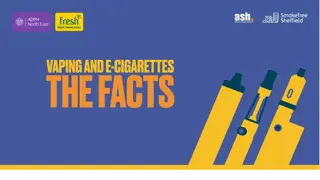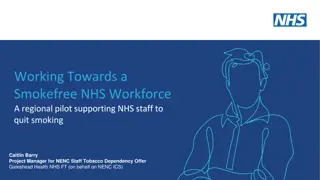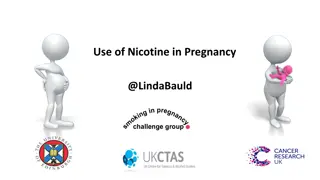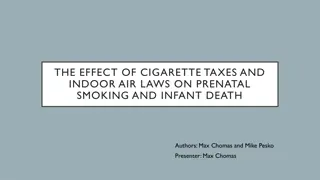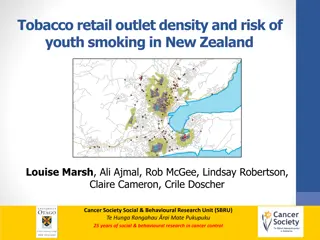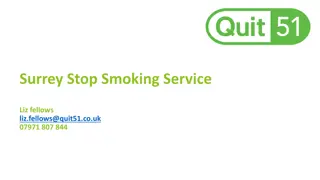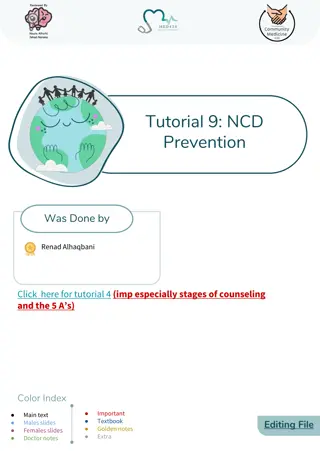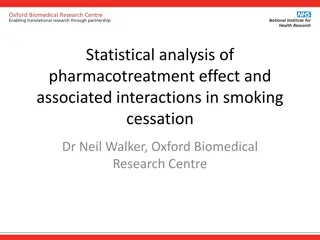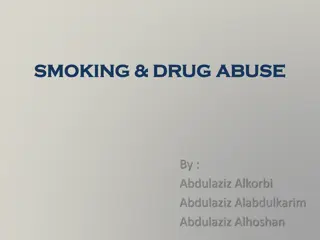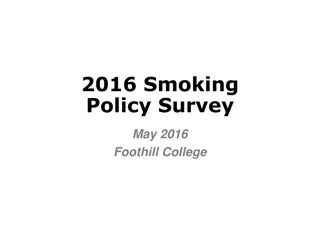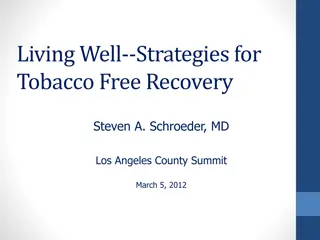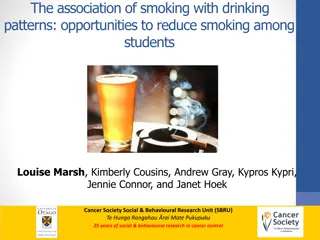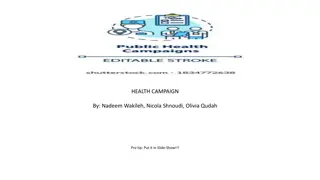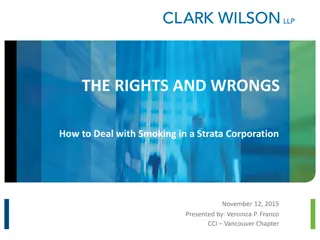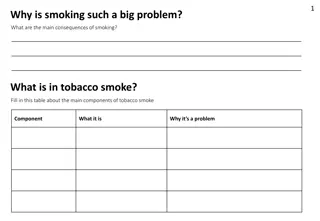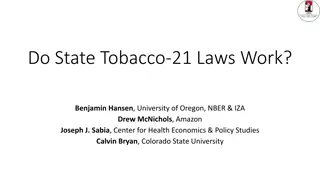The Harsh Reality of Smoking: A Global Health Concern
Smoking, encompassing cigarettes, cigars, and water pipes, remains a significant public health issue causing millions of deaths annually. The prevalence of smoking, especially in low-middle-income countries, poses a grave threat to individuals worldwide. Moreover, the dangers of secondhand smoke and the multitude of harmful substances found in tobacco products underscore the urgent need for tobacco control measures to combat this preventable cause of death and disability.
Download Presentation

Please find below an Image/Link to download the presentation.
The content on the website is provided AS IS for your information and personal use only. It may not be sold, licensed, or shared on other websites without obtaining consent from the author.If you encounter any issues during the download, it is possible that the publisher has removed the file from their server.
You are allowed to download the files provided on this website for personal or commercial use, subject to the condition that they are used lawfully. All files are the property of their respective owners.
The content on the website is provided AS IS for your information and personal use only. It may not be sold, licensed, or shared on other websites without obtaining consent from the author.
E N D
Presentation Transcript
SMOKING MazenAl-Fozan Mohammad Al-Ruwaili Mohammad Al-Harbi
Definition - Smoking refers to the inhalation and exhalation of fumes from burning tobacco in cigars, cigarettes and pipes. - The most common method :cigarettes, primarily industrially manufactured but also hand-rolled from loose tobacco and rolling paper. - Smoking is one of the most common forms of recreational drug use. - Other smoking implements include pipes,cigars,bidis,hookahs, . Etc.
Water-Pipe: - Not safer than regular tobacco smoke. - Causes the same diseases - Raises the risk of lip cancer, spreading infections like tuberculosis. - Users ingest about 100 times more lead from hookah smoke than from a cigarette.
Cigars: - Has larger amounts of tobacco than a cigarette - Is tobacco rolled up in a tobacco leaf - Does not have a filter
Magnitude of the problem: - 5 million premature deaths each year. - 600,000 Death due to 2nd hand smoking. - one person dies every six seconds. - 80% of smokers live in low-middle income countries - World s leading cause of death and disability in 2020/2030. - Approximately 1.1 billion smokers in the world - about 1/3 of the global population aged 15 years and over. - Consumption of tobacco is increasing globally, though it is decreasing in some high-income and upper middle- income countries.
Preventable Causes of Death Smoking 400,000 Accidents 94,000 2nd Hand Smoke 38,000 Alcohol 45,000 HIV/AIDS 32,600 Suicide 31,000 Homicide 21,000 Drugs 14,200
Prevalence of smoking among developed and developing countries
What is in cigars: More than 4,000 substances, including: Tar Tar: black sticky substance used to pave roads Nicotine Nicotine: Insecticide Carbon Monoxide Carbon Monoxide: Car exhaust 210 Polonium: radio-active substance Acetone Acetone: Finger nail polish remover Ammonia Ammonia: Toilet Cleaner Cadmium Cadmium: used batteries Ethanol Ethanol: Alcohol Arsenic Arsenic: Rat poison Butane Butane: Lighter Fluid 210 Polonium
Smoking in KSA - There were 34 studies between 1987 2008. 1. Adolescence: Range from 12-30% (median 16.5%) Global Youth Tobacco Survey (GYTS) in KSA in 2010 (ages 13-15) = -15% currently use any tobacco product (20% boys , 10% Girls) - 8.9 % currently smoke cigarettes (boys = 13.0 %, girls = 5.0%); - 9.5 % currently smoke shisha (boys = 13.3 %, girls = 6.1%) -
2. Early Adulthood: (university student) - 11 studies, mostly carried out on medical science student median of 14.5% The KSA medical students WHO-GHPSS was a school-based survey of 3rd year medical students attending the 13 medical schools conducted in 2006 Results: 11.6% currently smoke cigarettes (Males = 13.1%, Females = 9.6%); 12.8% currently use any form of tobacco other than cigarettes (Males = 13.9%, Females = 11.3%) 3. Adulthood: - 10 studies, median of 22.6% 4. Elderly: 1 study , 50-89 years old , 25%
Risk of smoking According to the 2004 Surgeon General s Report There is sufficient evidence that smoking causes the following conditions : Cancers : lung, oral (laryngeal) GI (esophageal, stomach, liver, pancreatic) GU (bladder, kidney, cervical) hematologic (myeloid leukemia)
Risk of smoking Cardiovascular disease: atherosclerosis cerebrovascular coronary heart disease(CHD) abdominal aortic aneurysm
Risk of smoking Respiratory disease: chronic obstructive pulmonary disease(COPD) increased susceptibility to pneumonia impaired lung growth during childhood and adolescence
Risk of smoking Reproductive effects: decreased fertility in women, complications of pregnancy , such as : o premature rupture of the membranes o placenta previa o placental abruption o miscarriage o still birth o low birth weight o reduced lung function in infants o sudden infantdeath syndrome (SIDS)
Risk of smoking Oro-dental Problems: Stained teeth Gum inflammation Black hairy tongue Oral cancer Overall poor oral health Delayed healing of the gums
Risk of smoking Consequences of chewing tobacco: Leukoplakia Oral cancer Leukoplakia is a condition which, in the mouth, can develop into cancer. Cigarette smoke and smokeless tobacco can cause this dangerous condition.
Risk of smoking Laryngeal Cancer : Symptoms: Persistent hoarseness Chronic sore throat Painful swallowing Pain in the ear Lump in the neck Over 80% of deaths from laryngeal cancer are linked to smoking
Risk of smoking Emphysema : Symptoms Include Shortness of breath; chronic cough; wheezing; anxiety; weight loss; ankle, feet and leg swelling; fatigue, etc
Risk of smoking Lung Cancer: The uncontrolled growth of abnormal cells in one or both lungs : Lung cancer kills more people than any other type of cancer
Risk of smoking Arteriosclerosis and Atherosclerosis: Nicotine affects fatty acids in the blood, increasing the overall blood cholesterol level. When cholesterol is too high, a hard substance called plaque builds up on the inside walls of the blood vessels. This condition is known as atherosclerosis. Plaque can clog the blood vessels, forcing the heart to pump harder. Smoking also constricts the arteries, leading to arteriosclerosis, or hardening of the arteries. These conditions greatly increase the risk for heart attacks or strokes.
Risk of smoking Peripheral Vascular Disease : Peripheral vascular disease, or PVD, is caused by the gradual narrowing of the arteries in the arms and legs. Smoking greatly increases the risk and severity of this disease by contributing to atherosclerosis in these tiny arteries. PVD causes painful cramping during exercise, numbness and tingling, and weakness in the affected limbs .
Risk of smoking Heart Attack: Smokers are twice as likely as Nonsmokers to have a heart attack A heart attack is when the heart is A heart attack is when the heart is damaged by a sudden lack of blood damaged by a sudden lack of blood flow to the heart muscle. This flow to the heart muscle. This happens because the arteries to the happens because the arteries to the heart muscle become narrowed or heart muscle become narrowed or blocked. Nicotine in cigarette smoke blocked. Nicotine in cigarette smoke causes blood vessels to become causes blood vessels to become narrow narrow Torn heart wall: Result of over-worked heart muscle
Risk of smoking Stroke: This brain shows stroke damage, which can cause death or severe mental or physical disability A stroke occurs when an A stroke occurs when an artery becomes clogged or artery becomes clogged or bursts. Strokes can cause bursts. Strokes can cause paralysis, brain damage, or paralysis, brain damage, or death. Hardened arteries, high death. Hardened arteries, high blood pressure, and clotting blood pressure, and clotting problems problems- - all of which can be all of which can be cause by smoking cause by smoking increase the risk for strokes. The dark the risk for strokes. The dark red area in the photo is where red area in the photo is where bleeding occurred bleeding occurred increase
Risk of smoking Other: hip fractures low bone density peptic ulcer disease cataracts diminished health status
Risk of smoking secondhand tobacco smoke : Is a significant health risk for nonsmokers, especially those with pre-existing respiratory and cardiac conditions. Is now a recognized carcinogen . containing over 50 harmful chemicals, such as : Formaldehyde benzene vinyl chloride arsenic ammonia hydrogen cyanide.
Risk of smoking Nonsmokers exposed to secondhand smoke at home or at work have about : 25% to 30% increased risk of heart disease 20% to 30% increased risk of lung cancer.
Risk of smoking Remember that Tobacco use is: The single largest cause of preventable death
How are you going to help the smoker to quite?
QUITTING PLAN Deciding to quit smoking Sure, you may be able to list plenty of reasons to stop smoking. You may be worried about the health problems related to smoking, the social stigma, the expense or the pressure from loved ones. But only you can decide when you're ready to stop smoking. You may spend a lot of time thinking about quitting smoking before you're ready to actually do it. If you're thinking about quitting, go ahead and pick a specific day to quit
QUITTING PLAN Picking a quit day Pick a specific day within the next month to quit smoking. Don't set your quit day too far in the future, or you may find it hard to follow through. But don't do it before you have a quit-smoking plan in place, either. Pick a random day as your quit day or pick a day that holds special meaning for you, such as a birthday, a holiday or a day of the week that's generally less stressful for you.
QUITTING PLAN AT THE QUIT DAY : Get rid of all cigarettes, ashtrays, lighters, and matches. Have creative alternatives available, such as : Using meswak Sugarless gum Sugarless candy A ball to squeeze Rubber bands Tell a lot of people that you ve quit smoking.
QUITTING PLAN AFTER QUIT DAY : Irritability, Fatigue, Insomnia, Cough, Dry throat, Nasal drip, Dizziness, Constipation, Gas, Hunger. most symptoms pass within two to four weeks. Craving for a cigarette. 1-Urges only last a few minutes. 2-Find out your personal reason and remembering them when things get a little tough 3-Do something to take your mind off smoking. 4-Don t ever take a cigarette from your friend not even a puff.
Your Role as a Friend 1)Don t nag, insult, or try to shame the smoker into quitting. 2) Let the smoker know that he is valued as a person. 3) Praise the smoker for even the smallest efforts to quit.
Role of PHC physician "smoking cessation clinic "
smoking cessation clinic the phusician should take the following:- 1-Body weight and height 2-CO level 1-2 (normal) 3-7 .(mild smoking) 8-22 ..(severe smoking) - Peak flow meter
Management of smoking cessation Pharmacological treatment . Non pharmacological treatment ( behavioral therapy ).
Management of smoking cessation Pharmacological treatment : 1. Nicotine based therapy 2. Non nicotine based therapy Both nicotine and non nicotine based therapy can increase the chances of successful smoking cessation.
Management of smoking cessation Nicotine based therapy (NBT) : Nicotine replacement therapy (NRT) : are available as transdermal patch, gum, nasal spray, inhaler, or iozenge.
Management of smoking cessation NRT : Reduces the withdrawal symptoms associated with smoking cessation such as anger, anxiety, craving, difficulty concentrating, hunger, impatience or restlessness.
Management of smoking cessation Effectiveness of NRT : There are two recent high-quality systematic reviews found all forms of NRT to be effective. In this study observed that the main factor determining the effectiveness of NRT was the level of the nicotine dependence. Anther study found little good evidence that NRT was effective for people who smoke fewer than 10-15 cigarettes daily . An additional cohort study found that nicotine patches were more effective in achieving long term cessation (52 weeks) in smoker with moderate dependence compared with those with mild to high dependence.
Management of smoking cessation Side effects of NRT : include local irritation depends on the route of administration. NRT is generally safe in patients with stable cardiovascular disease. Patient preference, cost, and side effect may be consideration when choosing NRT.
Management of smoking cessation Non nicotine based therapy : 1. Antidepressants . 2. Nicotine partial receptor agonists . 3. Other drug therapy .
Management of smoking cessation 1. Antidepressants: such as Bupropion is a selective serotonin\norepinephrine uptake inhibitor(SSNRI)
Management of smoking cessation Mechanism of action : 1. Improving depressive symptoms precipitated by quitting smoking. 2. Substituting for possible antidepressant effects of nicotine. 3. Independent neurologic effects such as nicotine receptor antagonist.









 undefined
undefined





